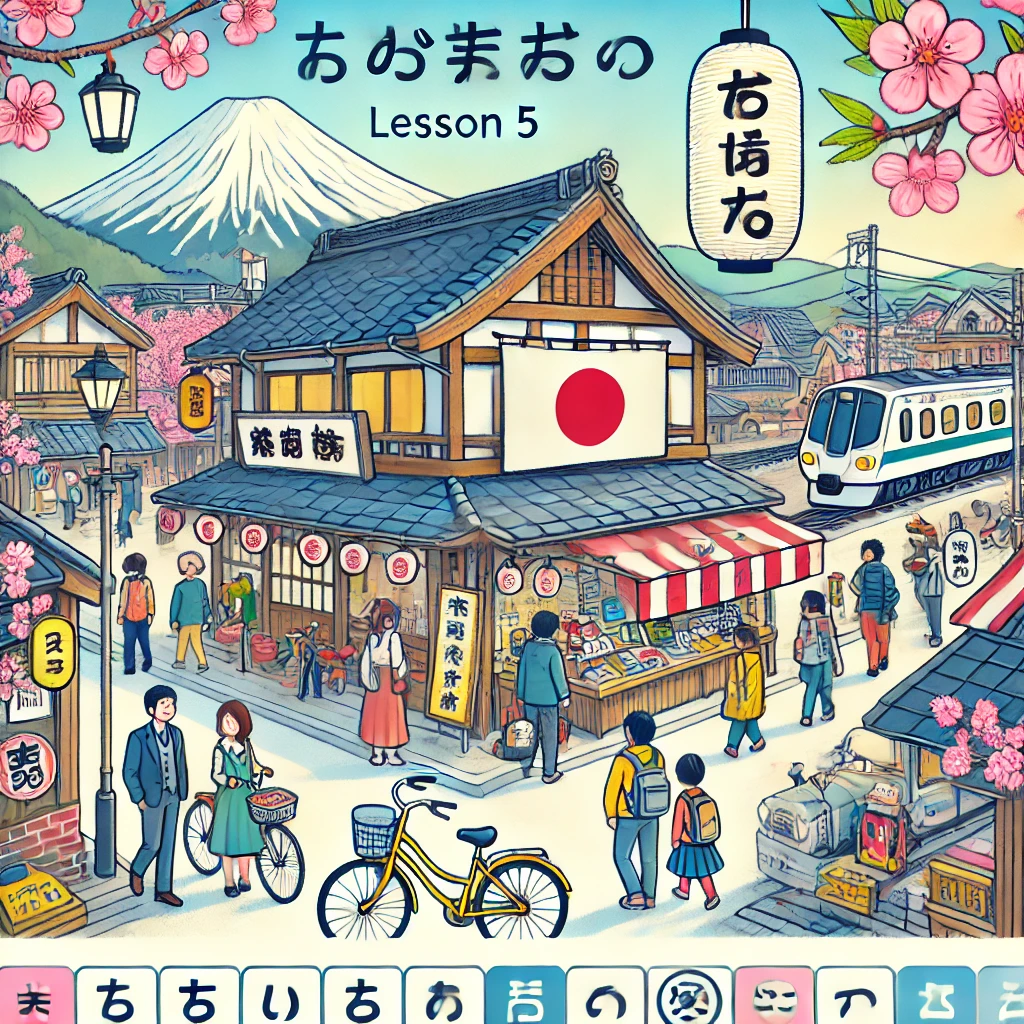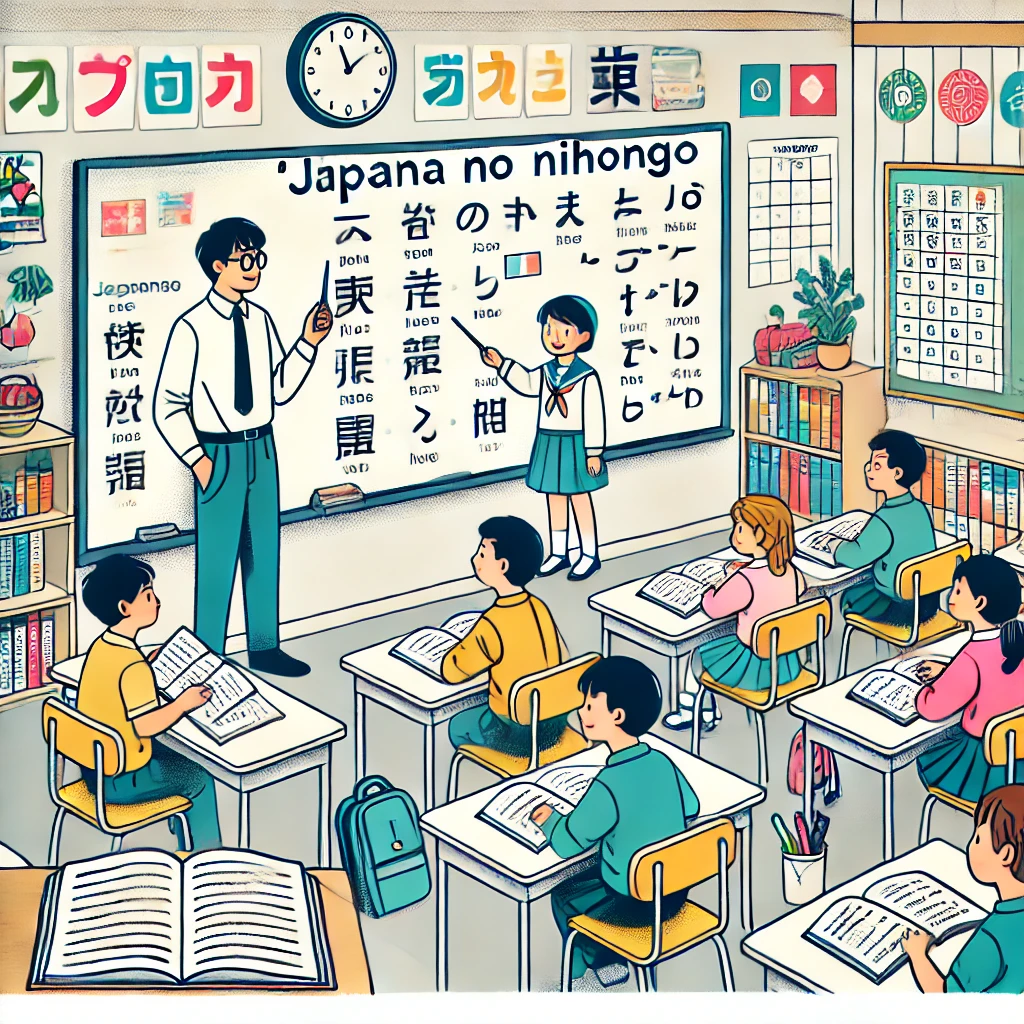If you’re diving into Japanese with the Minna no Nihongo series, Lesson 5 introduces crucial vocabulary that focuses on travel, transportation, and daily routines.
These words are essential for navigating life in Japan and building conversational fluency. In this article, we’ll explore the vocabulary from Lesson 5, provide examples, and share tips to help you memorize and use these terms effectively.
Mastering Minna no Nihongo Lesson 5 Vocabulary
1. Transportation and Movement Verbs (動詞 – Dōshi)
- いきます (ikimasu) – to go
- Example: がっこうにいきます。
(Gakkō ni ikimasu.) – I go to school.
- Example: がっこうにいきます。
- きます (kimasu) – to come
- Example: ともだちのいえにきます。
(Tomodachi no ie ni kimasu.) – I come to my friend’s house.
- Example: ともだちのいえにきます。
- かえります (kaerimasu) – to return, to go home
- Example: うちにかえります。
(Uchi ni kaerimasu.) – I go home.
- Example: うちにかえります。
2. Transportation Nouns (名詞 – Meishi)
- でんしゃ (densha) – train
- Example: でんしゃでいきます。
(Densha de ikimasu.) – I go by train.
- Example: でんしゃでいきます。
- くるま (kuruma) – car
- Example: くるまでかえります。
(Kuruma de kaerimasu.) – I return by car.
- Example: くるまでかえります。
- じてんしゃ (jitensha) – bicycle
- Example: じてんしゃにのります。
(Jitensha ni norimasu.) – I ride a bicycle.
- Example: じてんしゃにのります。
- ひこうき (hikōki) – airplane
- Example: ひこうきでとうきょうにいきます。
(Hikōki de Tōkyō ni ikimasu.) – I go to Tokyo by airplane.
- Example: ひこうきでとうきょうにいきます。
Read More: Minna no Nihongo Lesson 7 Grammar and Vocabulary
3. Places (場所 – Basho)
- がっこう (gakkō) – school
- Example: がっこうは9じにはじまります。
(Gakkō wa kuji ni hajimarimasu.) – School starts at 9 o’clock.
- Example: がっこうは9じにはじまります。
- スーパー (sūpā) – supermarket
- Example: スーパーでたべものをかいます。
(Sūpā de tabemono o kaimasu.) – I buy food at the supermarket.
- Example: スーパーでたべものをかいます。
- こうえん (kōen) – park
- Example: こうえんでさんぽをします。
(Kōen de sanpo o shimasu.) – I take a walk in the park.
- Example: こうえんでさんぽをします。
- えき (eki) – station
- Example: えきでともだちにあいます。
(Eki de tomodachi ni aimasu.) – I meet a friend at the station.
- Example: えきでともだちにあいます。
4. Time Expressions (時間 – Jikan)
- いつ (itsu) – when
- Example: いついきますか?
(Itsu ikimasu ka?) – When will you go?
- Example: いついきますか?
- こんしゅう (konshū) – this week
- Example: こんしゅうのどようびにいきます。
(Konshū no doyōbi ni ikimasu.) – I will go this Saturday.
- Example: こんしゅうのどようびにいきます。
- せんしゅう (senshū) – last week
- Example: せんしゅうきました。
(Senshū kimashita.) – I came last week.
- Example: せんしゅうきました。
- らいしゅう (raishū) – next week
- Example: らいしゅうかえります。
(Raishū kaerimasu.) – I will return next week.
- Example: らいしゅうかえります。

How to Study Lesson 5 Vocabulary Effectively
- Use Mnemonics
Create associations for each word to help you remember them. For instance, think of “densha” (train) as “dense with passengers.” - Practice with Real-Life Scenarios
Use the vocabulary while describing your daily commute or travel plans. - Engage in Active Recall
Test yourself using flashcards or apps like Anki to reinforce memory. - Watch Japanese Media
Pay attention to transportation-related conversations in Japanese dramas or anime to see how these words are used naturally.
Common Questions About Lesson 5 Vocabulary
Q: What makes Lesson 5 vocabulary unique in Minna no Nihongo?
A: Lesson 5 introduces essential travel and transportation terms, which are foundational for navigating Japan or discussing travel plans.
Q: How can I use these words in conversation?
A: Start with simple sentences like:
- こんしゅうはでんしゃでがっこうにいきます。
(Konshū wa densha de gakkō ni ikimasu.) – This week, I go to school by train.
Q: Are these words commonly used in Japan?
A: Absolutely! Words like “densha,” “eki,” and “ikimasu” are part of everyday conversations.
Minna no Nihongo Lesson 5 grammar
Key Grammar Points in Minna no Nihongo Lesson 5
1. いきます, きます, かえります (Verbs of Movement)
These three verbs are essential for discussing movement:
- いきます (ikimasu) – to go
- きます (kimasu) – to come
- かえります (kaerimasu) – to return/home
Structure:
[Subject] は [Place] に/へ [Verb]
- に (ni) or へ (e) indicates the direction or destination of movement. Both are interchangeable in this context.
Examples:
- がっこうにいきます。
(Gakkō ni ikimasu.) – I go to school. - ともだちのいえへきます。
(Tomodachi no ie e kimasu.) – I come to my friend’s house. - うちにかえります。
(Uchi ni kaerimasu.) – I return home.
2. Transportation Method + で (Using “de” for Means of Transportation)
To indicate the method of transportation, use the particle で (de) after the vehicle.
Structure:
[Vehicle] で [Destination] に/へ [Verb]
Examples:
- でんしゃでえきにいきます。
(Densha de eki ni ikimasu.) – I go to the station by train. - じてんしゃでこうえんへいきます。
(Jitensha de kōen e ikimasu.) – I go to the park by bicycle. - ひこうきでおおさかにいきます。
(Hikōki de Ōsaka ni ikimasu.) – I go to Osaka by airplane.
3. Time Expression + に (Using “ni” for Specific Times)
Use the particle に (ni) to indicate a specific point in time.
Structure:
[Time] に [Verb]
Examples:
- 9じにがっこうにいきます。
(Kuji ni gakkō ni ikimasu.) – I go to school at 9 o’clock. - こんしゅうのどようびにとうきょうへいきます。
(Konshū no doyōbi ni Tōkyō e ikimasu.) – I go to Tokyo this Saturday.
Note:
The particle に (ni) is not used for relative time expressions like “today,” “tomorrow,” or “next week.”
- Example: あしたがっこうへいきます。
(Ashita gakkō e ikimasu.) – I will go to school tomorrow.
4. Question Form: どこへ / なんで (Where and By What Means)
- どこへ (doko e) – Where to?
- なんで (nande) – By what means?
Examples:
- Question: どこへいきますか?
(Doko e ikimasu ka?) – Where are you going?
Answer: スーパーへいきます。
(Sūpā e ikimasu.) – I’m going to the supermarket. - Question: なんでがっこうへいきますか?
(Nande gakkō e ikimasu ka?) – How do you go to school?
Answer: じてんしゃでいきます。
(Jitensha de ikimasu.) – I go by bicycle.
5. Together with Someone: ~と (Using “to” for Companions)
The particle と (to) indicates that someone is accompanying you.
Structure:
[Person] と [Place] に/へ [Verb]
Examples:
- ともだちとえいがかんへいきます。
(Tomodachi to eigakan e ikimasu.) – I go to the cinema with my friend. - かぞくとうちにかえります。
(Kazoku to uchi ni kaerimasu.) – I return home with my family.

Tips for Mastering Lesson 5 Grammar
- Practice Daily
Use the sentence structures to talk about your daily activities or travel plans. - Flashcards for Particles
Create flashcards for particles like に, へ, で, and と to reinforce their usage. - Engage in Conversations
Practice with a language partner or tutor to build confidence. - Use Visual Aids
Create mind maps linking verbs, destinations, and transportation methods. - Immerse Yourself
Watch Japanese travel vlogs or listen to conversations involving movement to hear these patterns in action.
Read More: Minna no Nihongo Lesson 11 Vocabulary
FAQs About Lesson 5 Grammar
Q: Can I use に and へ interchangeably?
A: Yes, when indicating direction or destination, both are interchangeable. However, に has broader applications, such as marking specific times.
Q: Is the particle に always necessary for time expressions?
A: No, it’s optional for general time expressions like “morning” but required for specific times like “9 o’clock.”
Q: How can I remember when to use で versus に?
A: Think of で as describing “how” or “by what means,” while に specifies “where” or “when.”
Conclusion
The grammar structures in Minna no Nihongo Lesson 5 are fundamental for discussing movement, time, and companionship. By mastering these patterns, you’ll significantly improve your ability to talk about travel plans, daily routines, and more.
Start practicing these sentence patterns today, and watch your Japanese skills take off! Bookmark this guide to refer back to whenever you need a quick refresher. Happy learning!